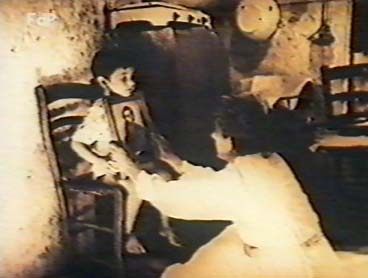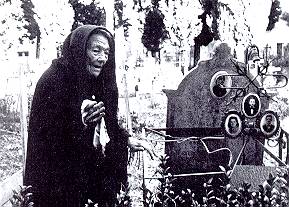| 4. The "work of pain" As a premise, I want to emphasize that the condition and status of women may change greatly in Southern Europe, depending, among other factors, on the different family-contexts where they happen to live. It is well known that in these regions we find examples of different habits ruling over marriage, the most important of which being the virilocal or uxorilocal customary residence. In uxorilocal contexts women could enjoy considerable support from their family: they lived in close contact with their parents and sisters and did not abandon their native place, friends and kin. To the contrary, as Loizos argued, in virilocal contexts married women "experience a dislocation from, and a consequent diminution of, their natal kinship based identity and are drawn into muteness", while "men seem to identify more closely with the household and use their identification in prestige-oriented action more than women" (Loizos and Papataxiarchis 1991: 15). The literature offers well-known examples of the latter situation. For instance, in his study of the Albanian patrilineal kin-group of the Ghegs, Whitaker points out that women were never integrated into their husband's clan (Whitaker 1976: 195-203). Furthermore, since these clans were traditionally exogamous and were used to exchange wives with another clan in order to create an alliance, women often found themselves in a very difficult situation when this alliance broke down. In some cases, the women went as far as to kill their children "as a desperate outlet to their predicament" (Peristiany 1976: 11). Apart from these extreme cases, it is well known that in virilocal contexts the wife was often considered "a stranger" in the household. Peristiany writes: "The internal strains and conflicts of these families result in 5.4 per cent of the wives (of the 195 cases under study) leaving their homes, while a considerable number suffer from neurosis or 'bedevilment'" (1976: 18). In these kinds of virilocal contexts, where women were often confined to a socially marginal and mute condition, the sphere of ritual and religious action was virtually the only one that women could resort to in order to express and possibly solve their psychological problems. This point may be illustrated by mentioning, as an example, the rite of the Anastenaria in Greek Macedonia. According to the local tradition, the Anastenaria is a religious feast that celebrates the rescue of the holy icons of Saint Constantine and Saint Helen, carried out by the Thracians in the XII century when the Bulgarians set on fire the church devoted to the two Saints. However, Loring Danforth has recently pointed out that this religious musical rite is also a "system of ritual psychotherapy […] concerned with the diagnosis and treatment of a wide variety of illnesses", mainly of a psychogenic nature (Danforth 1991: 99): in particular, it is a powerful means for women to express and solve the inner and social conflicts that cause the kind of neurosis mentioned by Peristiany. According to Danforth, women perform this therapeutic ritual within the sphere of the devotion to the Saints Constantine and Helen in order to represent and elaborate their inner pains and conflicts that result from their difficult relationships with their mother-in-laws. In fact, within the households of this virilocal community, "the position of the daughter-in-law is strictly subordinate to that of her mother-in-law" (103). Thus, the Anastenaria provides women with symbols and models of action through which they are able to articulate and express their inner tensions, such as dancing while holding an icon of Saints Constantine and Helen or a red kerchief, walking on fire, and singing the story of Mikrokostantinos. This last song, in particular, expresses symbolically the conflict between mother-in-law and daughter-in-law and is considered by Danforth an effective means of bringing to light and resolving this conflict. In conclusion, as Danforth says, "a woman's participation in the Anastenaria may actually restructure her family relationships in such a way as to resolve the conflicts present in her relationship with her mother-in-law. By becoming an Anastenarissa, a woman gains the support of her husband, since he is forced to commit himself publicly to helping her regain her health" (109). The case of the Anastenaria is a good example of the kind of "work of pain" - accomplished within the sphere of a religious event - that I mentioned before. We find a very similar case in the old phenomenon of tarantism, a therapy based on music and dance that was once particularly widespread in an area of Apulia called Salento in Southern Italy. "According to De Martino's interpretation, tarantism aims at symbolically representing and acting out a critical situation (a psychological struggle which is not possible to remember, thus leading to neurosis) affecting over all women during the age of sexual development. In this perspective, tarantism plays a very important role in Salento's society, since it allows the symbolic performance and socialization of a deeply critical individual conflict, which can be communicated and therefore loose its most dangerous features" (Magrini 1994: 71-72). For the marginal and "mute" women of Salento, who had no other cultural means to express their pain, tarantism functioned as a symbolic device for the cathartic expression of disease and as a conceptual framework with which to interpret it. Furthermore, tarantism also had a strong religious component, since Saint Paul of Galatina was considered the protector of tarantists and, at the same time, was sometimes identified with the taranta itself (De Martino 1976: 106). Pilgrimages to Galatina and devotion to Saint Paul were an integral part of the tarantists' behavior: during the feast of Saint Paul, the women affected by tarantism could act out their disease in a public context with the support of their families.
A tarantist speaking to the portrait of Saint Paul during the home therapy. Finally, I would like to mention briefly a further case of "work of pain" in the context of a religious rite celebrated every year in Campania, another region of Southern Italy. In the crowd of worshippers who proceed to the Sanctuary of the Madonna dell'Arco at Pomigliano d'Arco, near Naples, on Monday after Easter, I was able to observe women who fell down shouting as soon as they walked into the church and approached the holy icon. In this way, they were living publicly a private, psychological crisis, which was, however, perceived by most worshippers who attended the event as part of devotional behavior.
socially acceptable, rather than shameful. At the same time, these kinds of ritual-religious practice construct an image of femininity that is associated with the expression of psychological suffering. Thus, in these cases the "work of pain", even if it is not the exclusive property of women, is thought of as "gendered", i.e., a behavior mostly appropriate to the female world. This is consistent with the well-known association between femininity and the world of emotions (e.g., Lutz 1986), as well as between femininity and suffering: the "woman's position within the cycle of life is recognized as one which affords them an uneven share of suffering as well as privileged understanding […] As a mother, a woman has taken the first step in the hierarchy of 'understanding pain', an understanding which is the privileged territory of women" (Caraveli-Chavez 1980: 146). The women's skill in understanding and elaborating pain is testified first of all by their ability to deal with death. The ritual of funeral mourning is in fact an emblematic case of female "work of pain". This ritual was widespread in many Mediterranean countries well before the advent of Christianity: we find examples of it in the Bible and in the Iliad, in ancient Egypt as well as in ancient Rome, and these examples also include cases of male laments (e.g. De Martino 1975: 195, 199). Early Christianity found ritual mourning inconsistent with the message of the new religion. Indeed, the gospels report that, as Christ was going to the Calvary, the women began lamenting, at which point Christ said to them: "Daughters of Jerusalem, don't mourn me, but yourselves and your children" (Luca, 23, 27-29). Moreover, the gospels do not depict the mother of Christ in the act of lamenting his death, but rather as silently absorbed in her grief. We should remember, however, that syncretism deeply affected the development of Christianity in the Roman age: many ritual practices that could not be eradicated were absorbed in the new religion. In the Acta Pilati of the fifth century AD the Mother of Christ is depicted while performing the ritual mourning for Jesus - an image suggesting that this kind of ritual had by then been accepted by the new religion. We can assume, therefore, that the practice of ritual mourning was never completely discontinued until our century, when it was documented and studied by several scholars (e.g., De Martino 1975, Caraveli-Chavez 1980, Danforth 1982, Méndez 1988, Seremetakis 1991).
Women can bear the deep pain of lamenting the dead person and even making a show of themselves to express their sorrow. This "work of pain" is not a sign of weakness: on the contrary, the elaboration of grief through ritual mourning is hard work: a work that in "face to face" communities was essential, inasmuch as it carried a deep meaning both for the relatives of the dead person and for the entire community. Death shakes and restructures the community, which must endure the loss and process the connected feelings of fear, grief, and even protest against God. The technique of the lament, which airs and works out the different feelings connected to the loss, is conceived in view of erecting a permanent separation between the dead and the living and of transforming the fear of the dead person - believed to contaminate the world of the living - into a feeling of affectionate memory for the deceased. Thus, ritual mourning may be conceived as "a process by which a new reality is constructed and death finally accepted" (Danforth 1982: 141). The task of controlling and assimilating the feelings connected to death is entrusted to the women, who do this work not only for themselves, but also to benefit the whole community, engaged in the collective confrontation of death. However, the meaning of ritual mourning may go beyond this basic task and be related to specifically female issues. C. Nadia Seremetakis has pointed out the deeply gendered character of ritual mourning in Inner Mani, a region of the Peloponnese (Greece), and its role in asserting the power of women in this society: "Women represent the violence of death through their own bodies. Their postures, gestures, and general facial expressions function as corporeal texts which reaudit the experience of death as passage and disorder on behalf of the now silent and immobile dead […] This exposure of femininity in conjunction with ritual entry into the space of death signifies the breaking of those gender constrains that characterize the world of the living" (1991: 74). Moreover, Seremetakis argues that the kláma (the women's mourning ceremony) functioned as a true institution more than as an occasional event, and was endowed with indirect political and jural power: its opposition to the yerondikí (the all-male council) "expressed a pervasive feminine critique of the formal and informal control of the social order by men" (1991: 127). |


